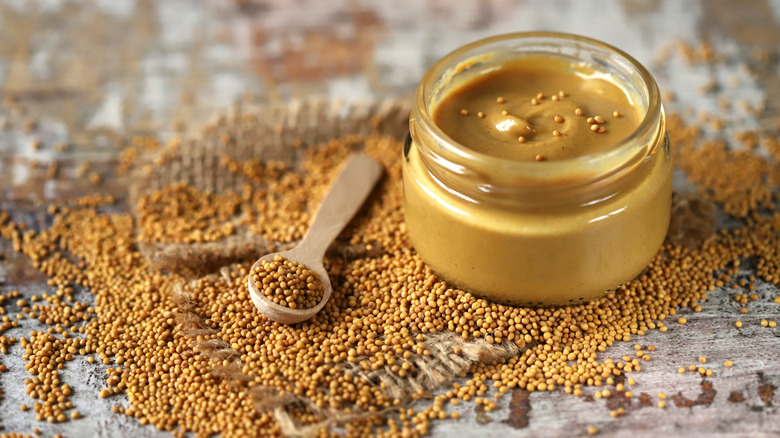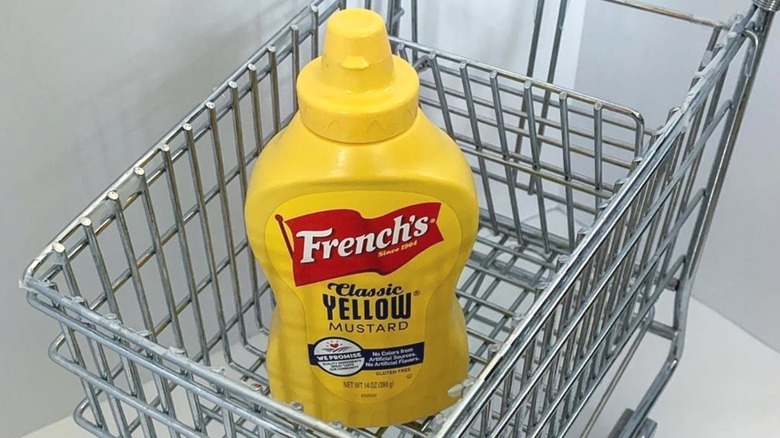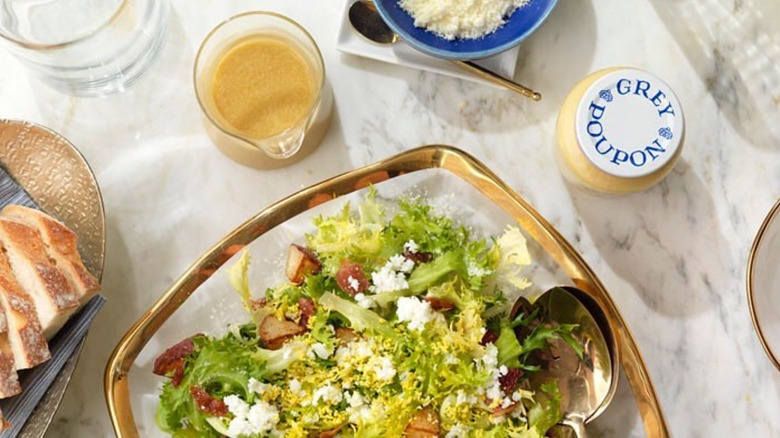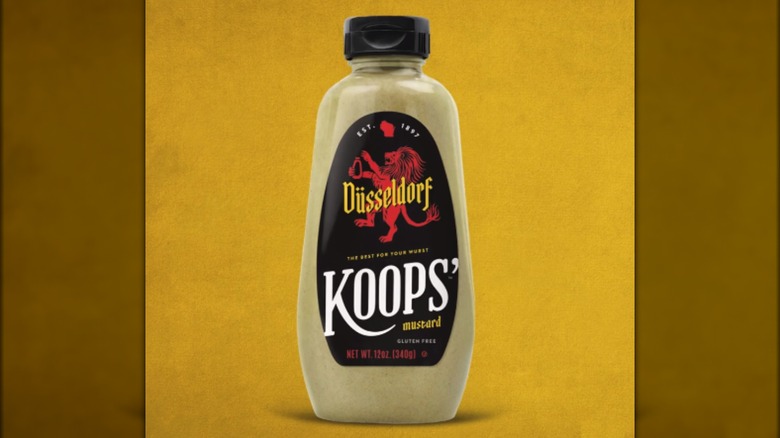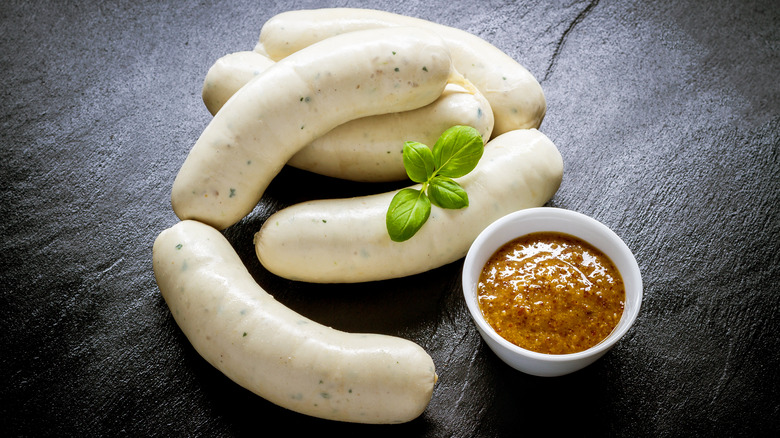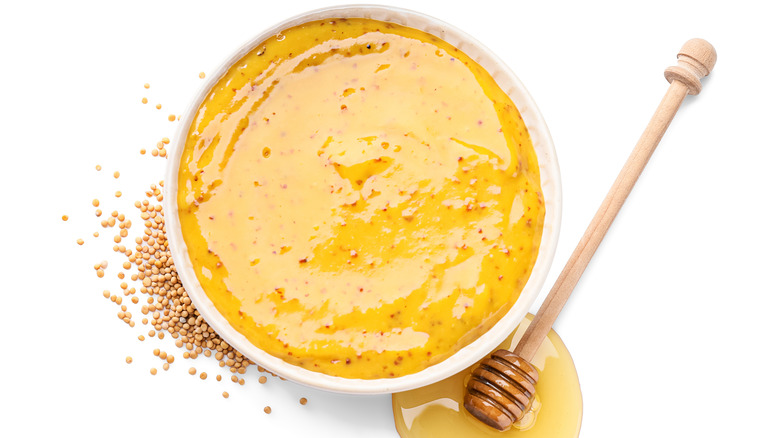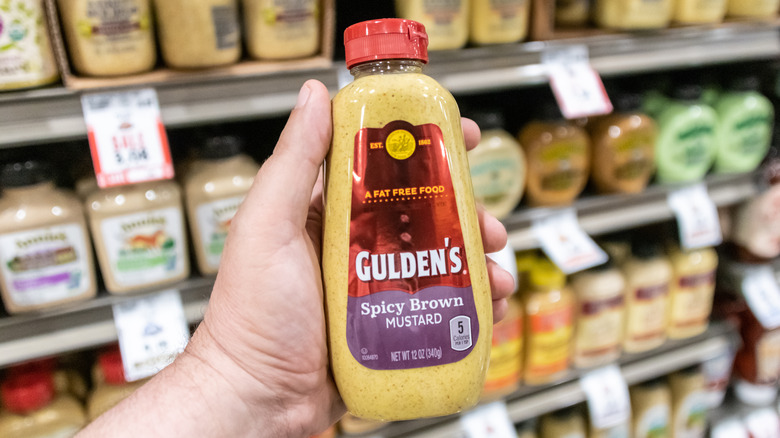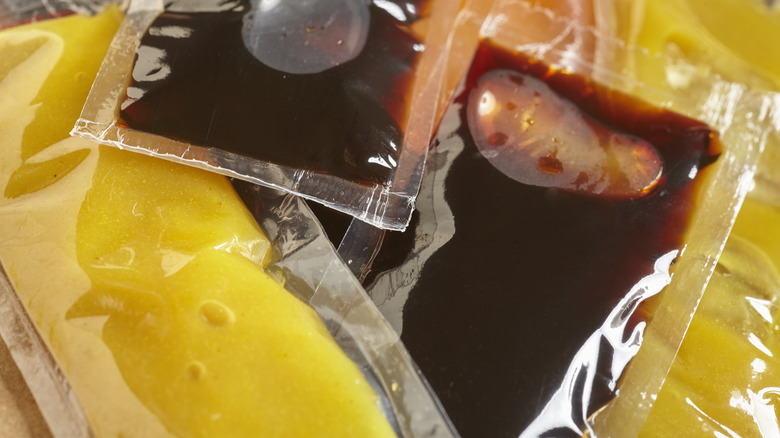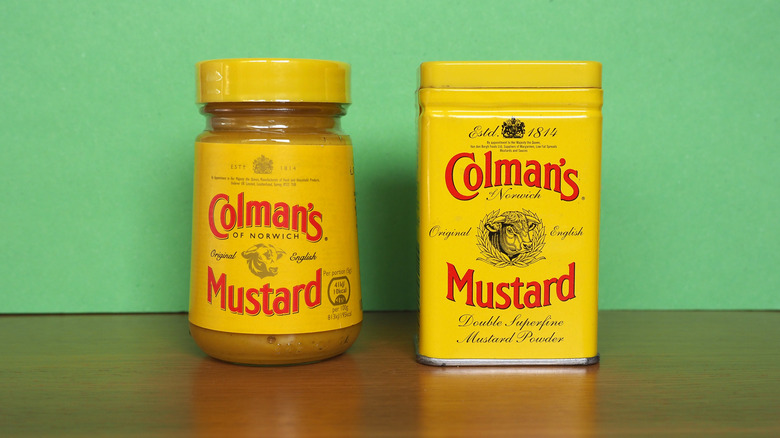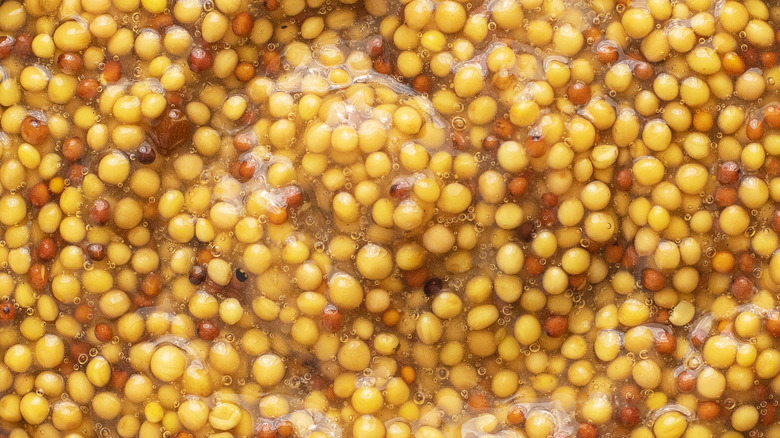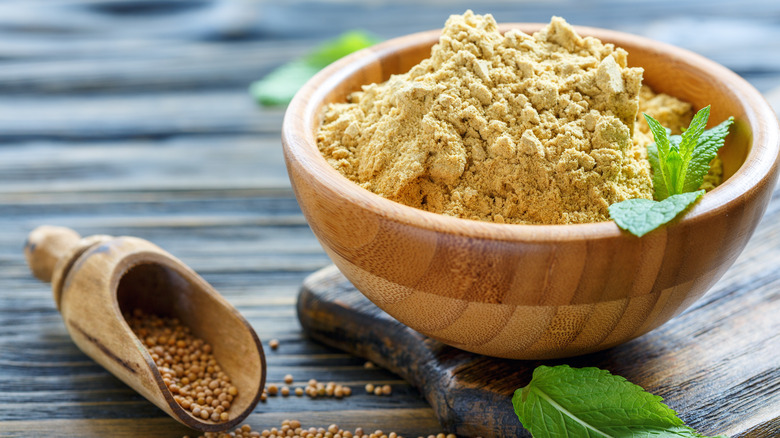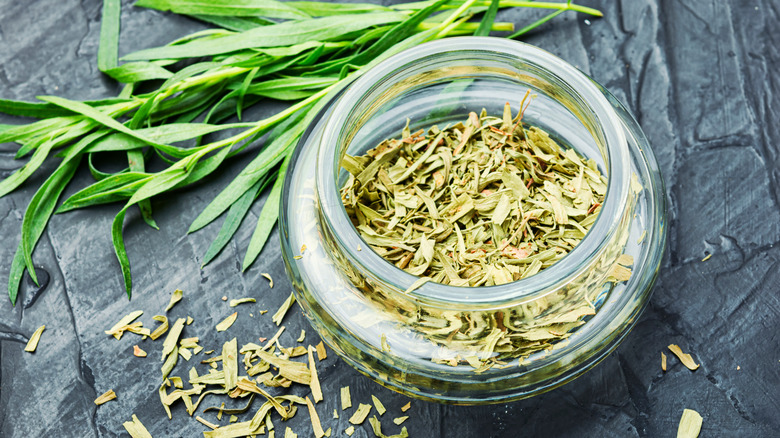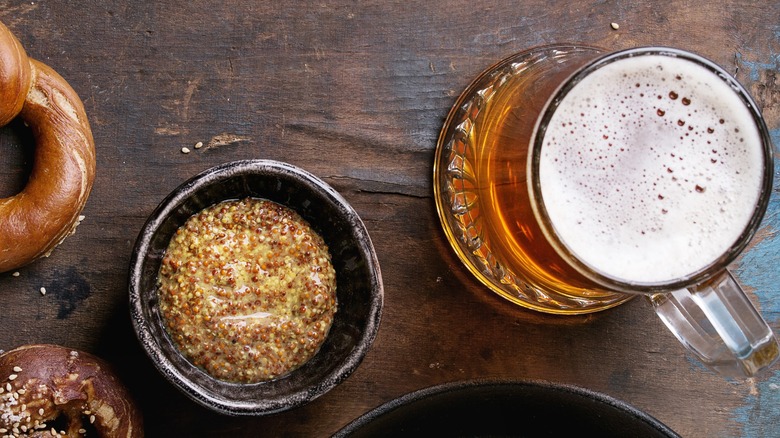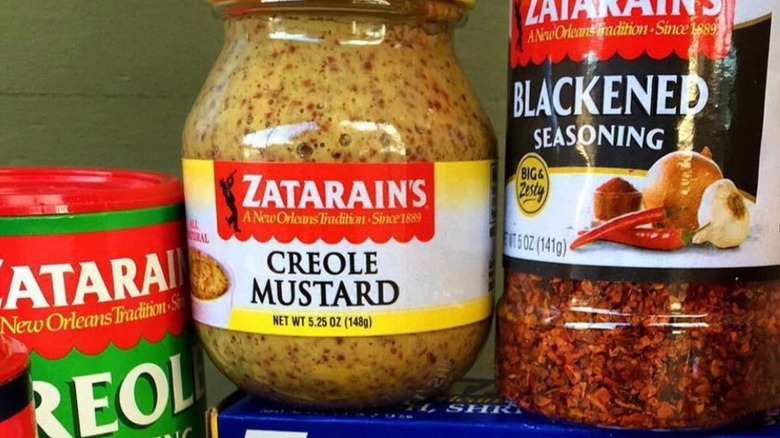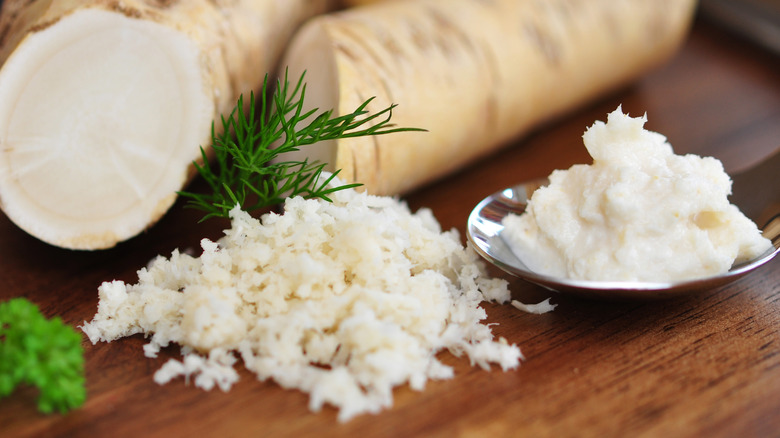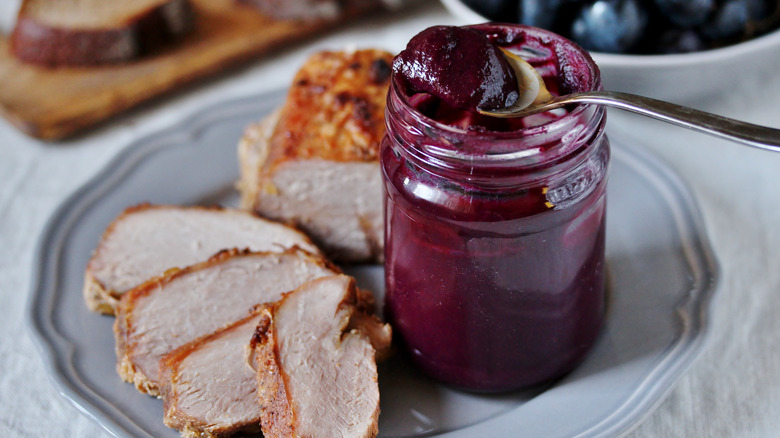The Most Popular Types Of Mustard And What To Do With Them
It's the condiment that launched a thousand stoplight requests in the '90s; a divisive but beloved topping for hot dogs and brats. It's a key ingredient in many vinaigrettes and a no-brainer when serving up a ham sandwich on rye. But despite bearing a simple, familiar moniker, mustard is far more complex than it may seem at first.
The word mustard refers at once to a condiment and to the little seed at its root: Mustard, at its very core, is a member of the cabbage and turnip family, per The Spruce Eats. But with over 40 different varieties belonging to the same plant family, mustard seeds — the main ingredient of the mustard condiment — can either be black, brown, white, or yellow. Black mustard is common in the Middle East and in Asia Minor, according to the outlet, while brown mustard seeds are more common in China and India. White or yellow mustard seeds, meanwhile, have long been preferred by Europeans, notes The Nibble, enjoyed as a condiment as far back as Ancient Greece.
From the color of mustard seed you use to the other ingredients added to craft the luscious, punch-packing spread, the flavor of the condiment we call "mustard" varies immensely from type to type — and each boasts its own specific ideal uses.
Yellow Mustard
One of the most common forms of mustard consumed in the U.S., it's hard to beat classic yellow mustard. First developed by George T. French — of the eponymous French's — yellow mustard's origins date back to the 1904 World's Fair in St. Louis, according to Wonderopolis.
This all-American iteration of the condiment gets its bright color thanks to the combination of white mustard seeds and a hefty hand with the turmeric. While many brands now make a yellow mustard, too, the original French's remains America's top mustard — yellow or otherwise (per maker McCormick & Company). French's version is made with top-grade mustard seeds combined with vinegar and a few spices to give it its familiar color and flavor.
According to Foods Guy, yellow mustard is known for being creamier than French Dijon, and it reigns supreme stateside; after all, it's widely known as "American yellow mustard." Its mild flavor (the mildest of all mustards, says Spoon University) is perfect on sandwiches and is the classic choice for hot dogs.
Dijon Mustard
Dijon mustard is familiar to most American home cooks thanks to the popularity of brands like Grey Poupon and Maille. But unlike yellow mustard, Foods Guy explains, Dijon is made with black and brown mustard seeds and is flavored with verjuice, a wine byproduct made from the juice of unripened wine grapes that give the mustard an acidic kick.
Dijon mustard, as its name suggests, originally hails from the French city of Dijon, located in Burgundy, where mustard plants are grown as cover crops to help provide nutrients for the grapevines used to make the region's famous wine, per The Spruce Eats. It's been a common regional condiment since the 1200s. According to The Nibble, this was likely the mustard brought to the U.S. — perhaps by Benjamin Franklin — that would later inspire the invention of yellow mustard.
Dijon mustard is available in both smooth and more textured forms, and, today, may be made with verjuice, vinegar, wine, or a combination of two or three. It's the perfect choice for jazzing up vinaigrettes, and it's a core ingredient in the French dish lapin à la moutarde, or rabbit with mustard sauce. In France, it is also frequently served as a condiment for roast chicken or a croque monsieur.
Düsseldorf Mustard
Germany may not be that far from France in terms of geography, but compare the cuisines of both countries, and you'll find loads of differences. One major one? The mustard.
Germany takes its mustard super seriously, with two major types of the condiment: one hailing from Bavaria and the other from Düsseldorf. The latter is more sweet-and-sour as compared to the former's sweeter flavor, and, as a member of the "sharf" or sharp category, it is quite spicy, per The Spruce Eats.
Düsseldorf mustard was the very first type of mustard condiment made and marketed in Germany, back in 1726, according to GermanFoods. To this day, it is made from whole mustard seeds rather than a powder (per Yümmy Bazaar), and while less acidic than some other mustards, its heat makes it the perfect accompaniment for typically German meats like sausages or smoked charcuterie.
Bavarian Mustard
Germany's other major mustard type is Bavarian mustard, known for being sweeter than most. Its invention, as GermanFoods explains, is attributed to Johann Conrad Develey, who, in the 19th century, combined both yellow and brown mustard with sugar, spices, and vinegar to create the hot-and-sweet condiment. It's a staple of Oktoberfest, not to mention everyday dining in Bavarian homes, according to Daring Gourmet.
Today, Bavarian mustard may be made with brown or white sugar or even molasses or applesauce, oer Yümmy Bazaar. It's a favorite with German sausages, particularly Bavarian Weisswürst, and it's lovely as an accompaniment for German hot pretzels (particularly with a stein of German beer!). You can find it in stores or even make it at home, which will allow you to control not just the heat of the mustard but the variety of sweet baking spices like clove and juniper that can be used.
Honey Mustard
Another sweeter mustard option, honey mustard is, as its name suggests, a condiment combining mustard and honey for a sauce at once sweet and spicy.
According to Spiceography, this combo dates all the way back to Ancient Egypt. It truly took off stateside, however, in the late '70s, when LA's Orange Hill restaurant gained particular acclaim for its honey mustard salad dressing.
Today, honey mustard's balanced flavor makes it the perfect choice to enjoy with cheese, for example, or as a different take on French fries. It can also be used to glaze meats like ham or chicken, or even go into a sandwich as a less assertive alternative to regular Dijon or yellow mustard. Honey mustard is also a favorite dipping sauce for wings, nuggets, and more, offering sweetness and the barest zingy kick for those whose palates aren't up for the starker heat of Buffalo-style sauces.
Brown Mustard
As a counterpoint to the more popular American staple of yellow mustard, brown mustard is much beloved as well.
This sauce boasts a higher concentration of brown mustard seeds as opposed to white, per Leaf, which are more commonly enjoyed as a spice in Indian, Chinese, and Japanese cuisines. But as a condiment, brown mustard is also a stalwart deli staple for those looking for a bit more heat on their ham on rye.
According to Serious Eats, in addition to its natural kick of heat, brown mustard often also boasts sweeter spices like allspice, ginger, cinnamon, and nutmeg for a balanced and aromatic flavor. Brown mustard also usually boasts more texture than yellow mustard, for instance, with bits of brown mustard seed still visible in the textured paste. Phenomenal on any classic deli sandwich from ham to turkey, mustard is a "must" with pastrami on rye.
Chinese Hot Mustard
If other mustards just don't pack enough heat, turn your attention to Chinese hot mustard. Perhaps most familiar thanks to its omnipresence in your Chinese takeout bags, the bright yellow mustard often given away in packets packs a true wallop of heat, according to the Woks of Life.
As The Spruce Eats explains, Chinese hot mustard gets its truly impressive kick thanks to a pure combo of spicy brown mustard seeds (as opposed to the white used in yellow mustard) and water (as opposed to the vinegar used to temper the same seeds for the preparation of brown mustard). With no additives like flour (and far more heat than tang), Chinese hot mustard wears its moniker well.
Chinese mustard is great with Chinese and Chinese-American dishes like spring rolls, egg rolls, and fried dumplings, its heat affording a lovely contrast, in particular, with sweeter or fried dishes.
English Mustard
As Serious Eats explains, English mustard is a kind of hot mustard, and the most well-known brand is Colman's. A British staple hailing from Norwich, England, Colman's Mustard has been beloved far and wide ever since it was first invented back in 1814. Made with a combination of both brown and white mustard seeds, per Le Comptoir Irlandais, Colman's prides itself on being "exceptionally different," with a hot yet tangy flavor so special that Queen Victoria declared it "The Queen's Mustard" by royal warrant!
Despite what you may have been led to believe about "bland" British food, Colman's is not for the weak of heart. Pungent and hot with a flavor reminiscent of horseradish, Colman's will really put some hair on your chest. Perhaps that's why it's purportedly a favorite of cooking show host Ted Allen's?
English mustard like Colman's can be used to add oomph to English roast dinners or even to sandwiches, and the powdered form is the classic not-so-secret ingredient in a stellar mac and cheese.
Whole Grain Mustard
Mustard can come in either smooth or whole grain aka grainy forms, and even some that are a combination of both. But perhaps one of the most popular of the whole grain mustard category hails from France, specifically Meaux, the same city known for one of the most popular Brie cheeses.
Invented back in 1632 Meaux mustard is made with a simple combination of mustard seeds, water, vinegar, salt, and spices. Its texture lends a pleasant "pop" with each mouthful!
The traditional container for this mustard is a crock with a cork lid and a wax seal keeping it fresh until you're ready to open it and enjoy. If you make French-style grainy mustard at home, you can opt for a combo of both brown and yellow mustard seeds and can even infuse it with other flavors like herbs, spices, or sweeteners. Much like Dijon mustard, Meaux mustard is delicious as an accompaniment to roast meats or whisked into a vinaigrette.
Dry Mustard
While most of the time, when we think of mustard, the image that comes to mind is the creamy paste we know and love, dry mustard is a kitchen staple that's actually a core ingredient in the condiment.
Used to season sauces or salad dressings, dry mustard boasts a purer mustard flavor than spreads, according to Catsup and Mustard, and that's no surprise: Other mustards are made by dissolving the powder in vinegar, wine, or verjuice; with dry mustard, all you get is the zip and heat of the pure spice.
Dry mustard can be made with any type of mustard seeds, be they white, yellow, black, or brown. That said, yellow mustard seeds are the most commonly used, according to Oola. Also known as powdered mustard, dry mustard is a not-so-secret ingredient in many mac and cheese recipes to add oomph and balance out all that rich cheese.
Tarragon Mustard
Mustard is often infused with other flavors, and while nearly any herb can be added to make a delicious spread, one particularly common choice in France is tarragon. Tarragon is a classic of French cuisine, with a pungent aroma reminiscent of licorice, anise, and fennel. It's a staple of sauce béarnaise, but, according to FoodPrint, it can quickly become overpowering if you use too much. Instead of buying a whole bunch, only to have it wilt before you have the chance to use it, one great way to infuse your cooking with more tarragon flavor is to opt for an infused mustard instead.
Boasting a deep green color, tarragon mustard is the ideal pair for fish, crayfish, or even meat. Some stir it into a cream sauce to drizzle over steak, and there are rumors that it may even be a secret ingredient of Paris' Relais de l'Entrecôte's creamy steak sauce.
Truffle Mustard
How can you turn mustard into a true special-occasion condiment? By adding truffles, of course! Truffle-infused mustard usually begins with a base of Dijon mustard, to which shavings of black truffle are added. Maille makes a version with Chablis white wine and Provençal black truffles, while Truffle Hunter uses both truffle and truffle flavoring for an even earthier aroma.
Since truffles are so sought-after and expensive, most companies will tell you exactly what percent of truffle is used in the final product. (Edmond Fallot, for example, uses a whopping 5%!). This doesn't just allow you to make sure your jar is worth the price, but it also makes it easier to seek out the truffleist of the lot.
Truffle mustard is a delicious way to turn any dish where you'd usually use regular Dijon mustard into a more special offering, paving the way for richer roast chicken or a snazzier steak. But consider giving it a starring role: as the main flavoring for a simple vinaigrette or homemade mayonnaise, for example.
Beer Mustard
While much French mustard is made with wine or verjuice, you can also opt for other alcohol-derived base flavors, including the hoppy herbaceousness of beer.
While beer and mustard have long been a frequent pair in countries like Germany, as both go particularly well with fatty sausages, beer-infused mustards are growing ever more popular as craft beers insert themselves into the mainstream more and more.
PS Seasoning, for example, makes four beer-infused craft mustards, infused respectively with Bavarian ale, pale ale and dill, jalapeño and German ale, or hot honey and ale. "Our company is deeply rooted in sausage making," says Ryan Johnson, director of sale and marketing at PS Seasoning, "and the beer-infused flavors are the perfect pairing with bratwurst and other deli counter offerings."
You can also use any leftover beer (yes, it exists!) to make your own beer mustard at home. We recommend using a hoppier beer for a bold flavor.
Creole Mustard
Hailing from New Orleans, creole mustard boasts a combo of the French, Spanish, and African flavors the local cuisine is known for. Creole mustard is defined by its stone-ground mustard base infused with Creole seasonings like onion, garlic, cayenne, and paprika. It also boasts a touch of sweetness from honey and molasses, according to Daring Gourmet.
Unlike French Dijon mustard, Creole mustard is often made with vinegar instead of white wine and spiked with a vinegar-based pepper sauce like Tabasco, per Gypsyplate. It may also have an even bigger kick thanks to the addition of horseradish!
You can either make your own Creole mustard at home or opt for a store-bought version, with brands like Zatarain's offering that perfect combo of texture and vibrancy. McCormick recommends pairing the condiment with fried fish or crawfish or even using it to jazz up the dressing of your favorite potato salad.
Horseradish Mustard
If you're looking for mustard with twice the horsepower, consider taking horseradish mustard for a spin.
Horseradish, according to The Spruce Eats, is a root vegetable belonging to the same family as mustard, wasabi, and cabbage. Known predominantly for its widespread use as a condiment, horseradish can either be purchased pre-grated in a jar or whole in root form to be grated at home. Horseradish also boasts some surprising health benefits, per WebMD, including working as a powerful anti-inflammatory, contributing to improved respiratory health, and boasting some phenomenal antioxidant power. (Plus, it clears your sinuses in a single bound.)
When infused into mustard, horseradish kicks the deep heat of the typical spread up to 11, for something that Mountain Feed dubs, quite simply, "fierce." The French's iteration of horseradish mustard, for example, unites depth and pungency for a condiment affording a lovely "kick" when drizzled on bratwurst, burgers and more.
Grape Must Mustard
While many French mustards are infused either with white wine or with verjuice, some specialty mustards are infused with another byproduct of the winemaking industry: grape must.
Must is a word used to describe freshly pressed grape juice. It is a product known for its thick texture and rich, opaque color, according to Drink Well, and is often used as a natural sweetener, particularly in winemaking areas. When combined with mustard, grape must lends its deep purple color and fruity character to the condiment, which isn't just easy on the eyes — it's also a phenomenal, slightly more nuanced spread than most. You can even find some grape must mustards infused with a single varietal, like the pinot noir Burgundy is known for.
Grape must mustard is best used when its beautiful purple color can shine on the plate. Serve it on a cheese board or in a glass jar, to accompany roast meat or poultry, for example.
